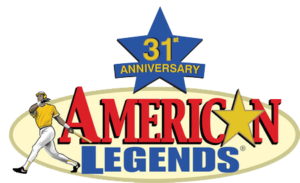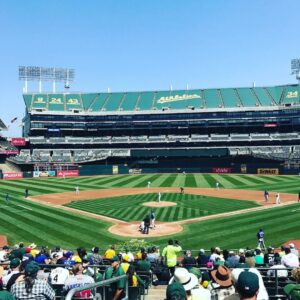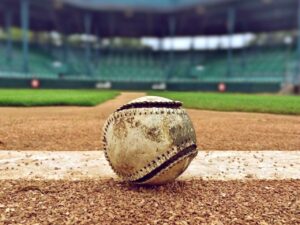Tom Seaver Baseball Cards
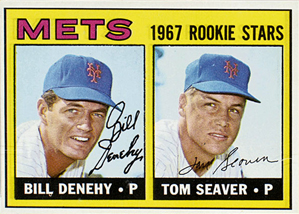
One could argue that the circumstances of Seaver becoming a Met helped the team shed its perpetually bad mojo.
George Thomas Seaver originally signed with the Braves but the Commissioner of Baseball voided the contract and the Mets eventually wound up winning his rights in a lottery.
Seaver joined the Mets in 1967 and won the National League Rookie of the Year Award, the first of four Mets pitchers to do so. Seaver appeared on his first trading card (along with not-so-legendary Bill Denehy) on the 1967 Topps #581 Mets Rookie Stars. The card appears in the short-printed high number series and is the most valuable card in the entire set.
Several months later, “The Franchise” was selected as the Mets lone representative in the All-Star Game in Anaheim. In an interview with Bill Madden of the New York Daily News, Seaver recounted his first All-Star appearance. “I remember walking into the National League clubhouse and looking around and seeing Aaron, Mays, Banks, Gibson, Clemente and thinking: What am I doing here? Then Lou Brock broke my thoughts by walking up to me and said: Hey kid, mind fetching me a Coke? I looked at him, stunned at first. Then, after realizing he wasn’t kidding, I had to tell him I was really a player, not the clubhouse kid. To this day, I’ve never let Lou forget that and every time I see him at Cooperstown or wherever, I’ll yell at him to fetch me a Coke!”
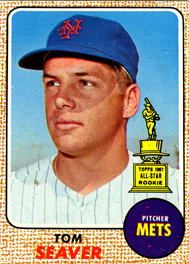
In 1968, Seaver was joined on the pitching staff by Jerry Koosman and Nolan Ryan, providing the Mets a trio of golden arms. Seaver had a second consecutive 16-win season for the 9th place club, pitching five shutouts in the process. He was once again selected for the All-Star game in the Astrodome and struck out five American Leaguers in two innings including Mickey Mantle.
Seaver’s 1968 Topps card, #45, features the Topps 1967 All-Rookie trophy on the right side of the card along with a chest up shot of Seaver. The card is often mistaken by novices for his actual rookie card. Topps was so enamored with the close-up of Seaver with his head turned to the left, that they used the identical photo on three of Seaver’s 1969 Topps cards; the 1969 Topps #480, the 1969 Topps Super #52 and the 1969 Topps Decals #38.
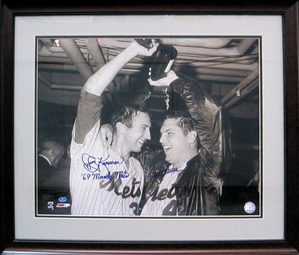
His signature performance came against the Cubs on the night of July 9th. Matched up against Ken Holtzman, Seaver pitched his “Imperfect Game,” 8 1/3 innings of perfect baseball before Jimmy Qualls’ soft single. Seaver retired the next two batters for an 11 strikeout one-hit performance.
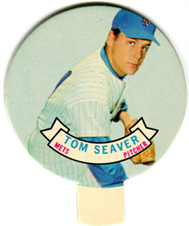
As the Mets only superstar, Seaver was the team’s featured player on literally every Topps test issue (1968 Action All-Stars, 1970 & 1973 Candy Lids, 1970 & 1977 Cloth Stickers, 1973 Comics, 1974 Deckle Edge, 1974 Stamps), Kellogg’s, Milk Duds, Transogram, Bazooka and O-Pee-Chee card until his departure in 1977.
The departure was known as the “Midnight Massacre.” After a falling out with Mets chairman, M. Donald Grant, Seaver was dealt to the Reds on June 15, 1977 for the forgettable package of Doug Flynn, Pat Zachary, Steve Henderson and Dan Norman. The Mets would spend the rest of the next six years in the doldrums playing in front of a near empty Shea Stadium, nicknamed Grant’s Tomb.
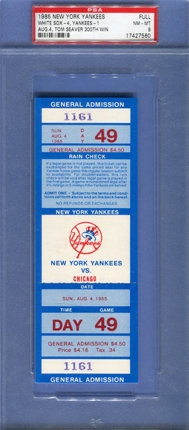
On May 9th, 1984, Seaver was credited with two victories over the Brewers after coming in for the final inning of a suspended game from the night before and winning his regular start.
The following year, Seaver captured his 300th win in front of a wildly cheering New York crowd. He was still a member of the White Sox, but Seaver beat the Yankees on Phil Rizzuto day on August 4th, 1985 at Yankee Stadium.
Seaver finished his career for the 1986 Boston Red Sox. Due to injury, Tom was inactive during the 1986 World Series against the Mets.
His induction in Cooperstown in 1992 was a fait accompli as he garnered the highest percentage of votes in Hall of Fame history.
His 2.86 Lifetime ERA (the 3rd lowest in the Live Ball era behind Whitey Ford & Sandy Koufax), five 20-game winning seasons and sixteen Opening Day starts prompted Reggie Jackson to declare “Blind men come to the park just to hear him pitch.”
If you have any Tom Seaver baseball cards (produced between 1967 and 1975) to sell or any items on our baseball buy list, PLEASE CONTACT Mark Rubin at 914-725-2225 or via email at mark@amerlegends.com. A quick phone call is all it takes to get started.
